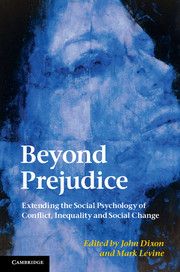Book contents
- Frontmatter
- Contents
- Figures
- Tables
- Contributors
- Acknowledgements
- Introduction
- Part I Beyond prejudice
- 1 From perception to mobilization: the shifting paradigm of prejudice
- 2 Prejudice, social identity and social change: resolving the Allportian problematic
- 3 An ambivalent alliance: hostile and benevolent sexism as complementary justifications for gender inequality
- 4 Prejudice and dehumanization
- 5 Stereotyping, prejudice and discrimination revisited
- 6 Beyond ‘old’ and ‘new’: for a social psychology of racism
- 7 The notion of ‘prejudice’: some rhetorical and ideological aspects
- 8 The prejudice problematic
- 9 Implicit prejudice in mind and interaction
- 10 Rethinking the prejudice problematic: a collaborative cognition approach
- Part II Prejudice and social change revisited
- Index
- References
3 - An ambivalent alliance: hostile and benevolent sexism as complementary justifications for gender inequality
from Part I - Beyond prejudice
Published online by Cambridge University Press: 05 June 2012
- Frontmatter
- Contents
- Figures
- Tables
- Contributors
- Acknowledgements
- Introduction
- Part I Beyond prejudice
- 1 From perception to mobilization: the shifting paradigm of prejudice
- 2 Prejudice, social identity and social change: resolving the Allportian problematic
- 3 An ambivalent alliance: hostile and benevolent sexism as complementary justifications for gender inequality
- 4 Prejudice and dehumanization
- 5 Stereotyping, prejudice and discrimination revisited
- 6 Beyond ‘old’ and ‘new’: for a social psychology of racism
- 7 The notion of ‘prejudice’: some rhetorical and ideological aspects
- 8 The prejudice problematic
- 9 Implicit prejudice in mind and interaction
- 10 Rethinking the prejudice problematic: a collaborative cognition approach
- Part II Prejudice and social change revisited
- Index
- References
Summary
If woman had no existence save in the fiction written by men, one would imagine her a person . . . very various; heroic and mean; splendid and sordid; infinitely beautiful and hideous in the extreme.
Virginia Woolf, A Room of One’s Own (1929/1981)What Woolf saw as ‘astonishing extremes’ in men’s images of women date back to ancient texts. Pomeroy (1975), a social historian, suggested that classical representations of women fit into the polarized categories of goddesses, whores, wives and slaves. Feminists who analyse contemporary society (e.g. Faludi, 1992) argue that similarly extreme characterizations of women are alive and well in popular culture, such as film depictions that divide women into faithful wives and murderous seductresses. Although what Tavris and Wade (1984) termed the pedestal–gutter syndrome (or the Madonna–whore dichotomy) has long been recognized by psychologists, historians and feminists, most empirical researchers have identified sexism only with regard to hostility towards women, ignoring the corresponding tendency to place (at least some) women on a pedestal.
This chapter reviews recent theory and empirical research on hostile and benevolent sexism. Hostile sexism is an adversarial view of gender relations in which women are perceived as seeking to control men, whether through sexuality or feminist ideology. Although benevolent sexism may sound oxymoronic, this term recognizes that some forms of sexism are, for the perpetrator, subjectively benevolent, characterizing women as pure creatures who ought to be protected, supported and adored and whose love is necessary to make a man complete. This idealization of women simultaneously implies that they are weak and best suited for conventional gender roles; being put on a pedestal is confining, yet the man who places a woman there is likely to interpret this as cherishing, rather than restricting, her (and many women may agree). Despite the greater social acceptability of benevolent sexism, our research suggests that it serves as a crucial complement to hostile sexism that helps to pacify women’s resistance to societal gender inequality.
- Type
- Chapter
- Information
- Beyond PrejudiceExtending the Social Psychology of Conflict, Inequality and Social Change, pp. 70 - 88Publisher: Cambridge University PressPrint publication year: 2012
References
- 31
- Cited by

